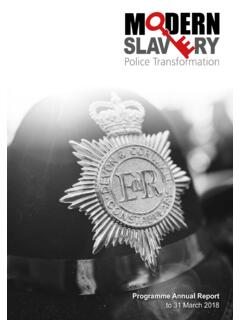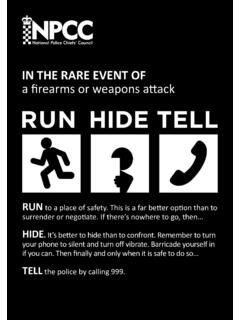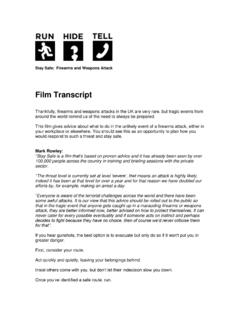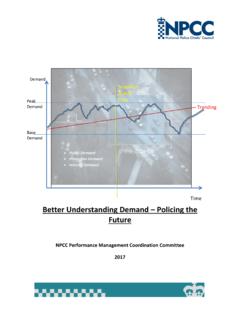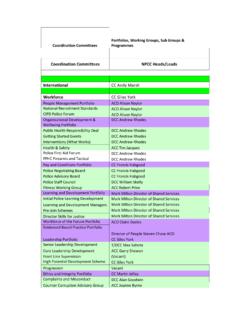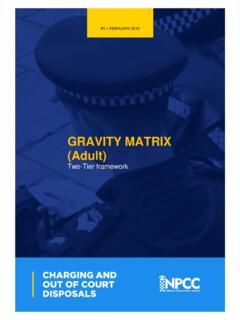Transcription of Automatic Number Plate Recognition (ANPR)
1 1st Floor, 10 Victoria Street, London SW1H 0NN T 020 7084 8950 F 020 7084 8951 Automatic Number Plate Recognition (ANPR) Factsheet April 2016 What is ANPR and how does it work? ANPR consist of a camera that is linked to a computer. When a vehicle passes by the camera the camera records an image which is automatically read by the computer and the vehicle registration mark (VRM) recorded. Who uses the Law Enforcement ANPR infrastructure? The Law Enforcement Agencies (LEA) including the police use ANPR within the law enforcement National ANPR Infrastructure (NAI). The LEA who may access the NAI are Approved LEA which are listed in National ANPR Standards for Policing (NASP). Does anyone else use ANPR? ANPR is also used by private companies, local authorities and the Department for Transport to monitor traffic flows and for car park management. Are ANPR reads from Private Companies checked against police databases?
2 No, the Law Enforcement NAI does not receive data that has been processed by other organisations for these purposes and no data from police databases is disclosed to them. Do Private companies receive data from the police to check against their systems? No police data is supplied to private companies. Some are able to obtain details of a registered keeper for a vehicle directly from the Driver and Vehicle Licensing Agency (DVLA). (Eg to enforce a civil penalty for exceeding authorised free parking in a superstore car park.) ANPR is used for average speed enforcement, is that data held in the Law Enforcement ANPR database? No there are no links between the law enforcement database and speed enforcement systems. Why do Law Enforcement Agencies (LEA) use ANPR? ANPR technology is used to help detect, deter and disrupt criminality at a local, force, regional and national level, including tackling traveling criminals, Organised Crime Groups and terrorists.
3 How does ANPR assist? ANPR is used to support the following activities: Operational Response As a vehicle passes an ANPR camera, its registration Number is read and instantly checked against database records of vehicles of interest (VOI). If the vehicle is listed as a VOI Police officers can intercept and stop a vehicle, check it for evidence and, where necessary, make arrests. Information and Intelligence VOI that are of interest particularly for in relation to national security or have been linked to and organised crime purposes can be circulated and as they pass an ANPR camera details are recorded for information of investigation teams. Investigations The record for all vehicles passing by a camera, including those for vehicles that are not known to be of interest at the time of the ANPR read may in appropriate circumstances be accessed for investigative purposes. The use of ANPR in this way has proved to be important in the detection of many offences, including locating stolen vehicles, tackling uninsured vehicle use and solving cases of terrorism, major and organised crime.
4 Is data from Private Companies, Department for Transport and local Authorities checked against LEA Vehicle of Interest lists? No, only data collected by law enforcement agencies within the Law Enforcement NAI is checked against the NAI. Other organisations have no access to that data. How big is the Law Enforcement NAI? The Law Enforcement NAI consists of a network of ANPR cameras that collect data at a local police force level. The majority of data collected locally is then sent to the National ANPR Data Centre (NADC). At present approximately 9000 cameras submit between 25 and nearly 40 million reads daily to the NADC. Data is retained for 2 years on the NADC. Approximately 20 billion read records are held. How are the locations for cameras decided? The National ANPR Standards for Policing (NASP) provide details of the criteria for deploying ANPR cameras. Cameras can only be deployed at locations following a strategic assessment that identifies a need for ANPR at that location to detect, deter and disrupt criminality.
5 Strategic assessment should take account of: National Security and Counter Terrorism Serious, Organised and Major Crime Local crime Community Confidence and Reassurance, Crime Prevention and Reduction. Where a need is identified the camera may only be deployed if it is assessed as being appropriate and proportionate in balancing the protection of the public with the rights and individual expectations of privacy. How long are cameras deployed at a location? National ANPR Standards for Policing (NASP) require that the continued requirement for a camera at a location is monitored and the device removed should the justification for deployment cease. It is a requirement that all deployments are reviewed at least annually. Where are the fixed site cameras? It is national policy that details of fixed site ANPR locations are not disclosed, as this information is likely to be of benefit to offenders and if known could reduce the value of ANPR to law enforcement.
6 The merits of disclosure have been considered by the Information Tribunal in the case of Mathieson have concluded that it is on balance in the public interest that locations are not disclosed to ensure that the value to law enforcement is maintained. How are vehicle mounted ANPR cameras used? Vehicle-mounted ANPR may only be deployed where any of the following circumstances arise: For the purposes of monitoring hits against a list of vehicles of interest (VOI) with the intention that an operational response to the hit will take place, either by staff within the vehicle containing the ANPR system or by others deployed in support of that vehicle for the purpose of providing a response. Deployed at locations identified in accordance for a fixed site camera prior to the deployment of a camera at the location. Deployed as a result of Operational tasking processes within an LEA where it has been determined that it is proportionate for short term deployment of ANPR; o In response to identified criminal activity o In response to identified community problems o To support assessment of a location for future more permanent camera deployment at the location.
7 In support of immediate operational response following report of a crime or incident. Some media reports indicate that every journey is monitored. Is that true? No however given that LEA collect a large Number of ANPR reads every day and store them for 2 years the question deserves a more detailed explanation. Monitored? It is true that cameras record the presence of a vehicle at a location but in the majority of cases (well over 90%) that record is never accessed and it is deleted from the system in line with the retention policy. (2 years) Monitoring requires more than simply collecting and recording the data. The record is retained as at the time of recording it is not possible to identify all the vehicles that may be of interest and to separate them from the others that are of no interest. The need to access a record may not arise until sometime after the read is recorded by the camera, which can be months or even years after an offence is committed.
8 Can the Read be linked to a person? It is accepted that ANPR data is personal data within the meaning of the Data Protection Act 1998 (DPA). A Vehicle Registration Mark (VRM) is not in itself personal data however since LEA can in most cases access data that links a person to the vehicle, for example the name of the registered keeper it is personal data within the meaning of the DPA. LEA do not however, have ready access to another data source for a significant Number of vehicles as only approx 80% of all vehicles are private cars registered to a named keeper. Personal data for the 20% of vehicles registered for example to companies can only be obtained if for example an offence has been committed and the registered keeper can be required to provide details of the driver. Which journeys are recorded and are records of movements personal data ? Whilst it is not appropriate to disclose the locations of ANPR cameras it is true that, taking account of privacy impacts, most are located on higher volume traffic routes and not within residential areas.
9 Assuming that all cars, privately registered and company registered, complete the same annual mileage and travel the same proportion of those miles on higher volume traffic roads (which is unlikely), a maximum of 70% of reads recorded within the NAI will be Personal data within the meaning of the DPA. Since it is not possible to identify which reads relate to a vehicle that is privately registered all are treated as items of personal data within the NAI. How many cameras are likely to be passed on a journey? There are approximately 246,000 miles of roads in Great Britain and therefore an average of 1 camera every miles based on the 9,000 cameras feeding the NADC being equally spaced along those roads. However a proportion of cameras are vehicle based and more than one camera is at some locations covering multiple lanes of a road a direction of travel, so the average distance between cameras will be greater.
10 In reality many journeys will be conducted without passing a LEA ANPR camera. Access Controls The National ANPR Standards for Policing (NASP) include clear rules to control access to data within the NAI. Access may only be by authorised persons for investigation and intelligence purposes. These controls ensure that the majority of ANPR read records enter the system automatically as a vehicle passes by a camera and are then deleted from the system without ever being accessed in the interim period. Copies of NASP can be seen at What is the relevance of the Surveillance Camera Code of Practice (SCC)? The SCC is issued under provisions of the Protection of Freedoms Act 2012 and the police service is a relevant authority within the meaning of the code and required to have regard to the code. The guiding principles within the Code have their origins in Law Enforcement ANPR Principles.
